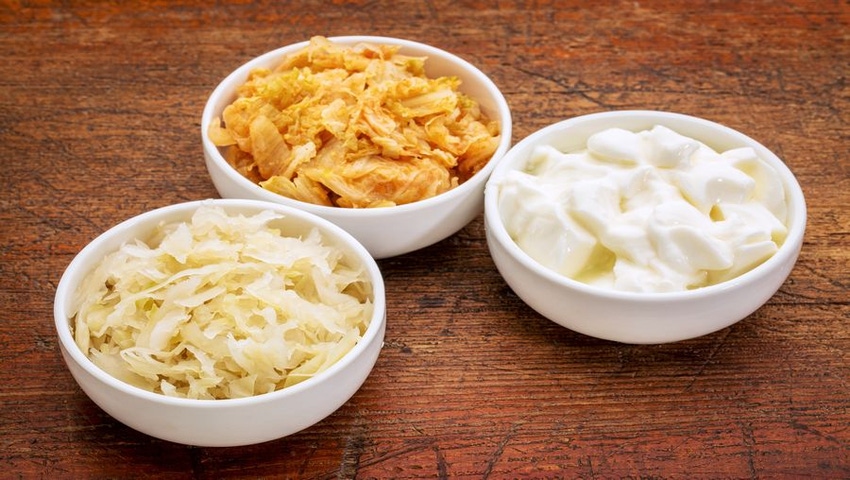Dairy, baby food, healthcare products, desserts, ice cream and snacks are leading categories for probiotics; emerging categories in food with probiotics include juice drinks, bakery, chocolate confectionery and savory spreads.
November 21, 2017

The global market for probiotic ingredients in 2017 is valued at US$36.6 billion. This is predicted to exceed $64 billion by 2023, according to Global Market Insights Inc. Dairy accounts for 69 percent of the probiotics market, baby food 12 percent, health care 8 percent and desserts, ice cream and snacks 2 percent each. Other emerging categories in food with probiotics include juice drinks, bakery, chocolate confectionery and savory spreads. (Mintel Global New Products Database)
Scientists have verified probiotic bacteria play a critical role not just in helping maintain a good digestive function, but they have a larger role in keeping the body healthy. As the importance of a healthy gut microbiota in keeping us healthy becomes better understood and the message reaches to more people, demand for probiotic-based food products will rise.
Fermented foods, many of which contain probiotic bacteria have been part of our diet since ancient times. Yogurt and yogurt-related drinks have formed an integral part of the diet of Asian Indians since the emergence of settled life. An association of probiotics and wine has also been made by some. [Link to http://www.yalescientific.org/2014/11/salud-to-the-microbe-the-probiotic-potential-of-wine/]
Traditional food such as kimchi from Korea, kefir (a yogurt-based drink from Russia and Turkey), kombucha (fermented carrot pickle drink common in North India), sauerkraut, etc., are fermented food and drink that form part of the traditional food of people across the globe.
In September 2016, Tropicana launched a range of probiotic juices. A year prior, the juice brand Suja introduced a range of probiotic waters in the U.S. market. Chocolate bars containing lactobacillus and bifidobacterium probiotic bacteria have also been introduced.
Dark chocolate is said to improve gut microflora. Chocolate has been found to be a potential protective carrier for oral delivery of probiotic bacteria. (Int J Food Microbiol. 2010;141(1):97-103.)
Plant-based probiotic kale and broccoli poppers have been introduced by Brad’s Plant in the U.S. market. Probiotic spaghetti products introduced in Iran, muesli with probiotic in India, pancake and waffle mix with ancient grains in Puerto Rico, and durum wheat semolina spaghetti containing probiotic bacteria are some other examples of innovative non-dairy probiotic products being sold in different parts of the world.
In the dairy product space, beyond yogurt, baby food, ice cream and desserts, fermented foods are becoming the target for innovation. Cottage cheese with live and active cultures of probiotic bacteria including Streptococcus thermophilus has been introduced.
Kefir probiotic-fermented milk under different brands is available. The scientific evidence in support of probiotic foods has mounted over the years. Food product manufacturers are leveraging this evidence to produce and market innovative snack and beverage products to health-conscious consumers in different parts of the world.
The pace of innovation in health products is rising. It is just a matter of time when consumers will soon be spoilt for choice. An entire range of probiotic fermented vegetables- waters, fruit and dairy ingredients- have been developed. These products carry labels like “live and active cultures.”
Probiotic product innovation is expanding beyond food. Probiotic toothpastes and mouth rinses containing lactobacillus bacteria have been introduced into the Chinese market. A scientific analysis on the ability of these products to prevent oral infectious diseases such as caries and periodontal disease have been conducted and initial results appear positive. (Medicinski glasnik. 2017;14(1):139-144.)
Many of the probiotics food product innovations contain prebiotics. Prebiotics are fiber-like ingredients that help improve bowel movement, and help build the gut environment wherein microbiota flourish. Prebiotics-based products carry labels like “contains inulin fiber” or “fiber helps to improve intestinal transit.” Another prebiotic gaining popularity is galactooligosaccharides. These have been shown to improve bowel function. (Scandinavian J Food Nutr. 2007;51(2):62-66.)
Popular probiotic and prebiotic combination products encountered in traditional Asian and Asia Pacific cuisine include:
Yogurt or kefir and honey
Yogurt or kefir with honey and acacia gum
Beans and pickles
Yogurt, source cream or kefir with garlic
Feta cheese and onions
Yogurt with oats
Greens sautéed with garlic and sour cream
Kombucha with chia seeds
Kombucha with acacia gum
Yogurt or kefir with chia seeds, acacia gum and honey
Sour pickled onions and pickled garlic
Sour pickled asparagus
As the understanding of role of probiotics and prebiotics combination foods increases, food manufacturers are coming up with new and innovative products suitable and specific to palates of different parts of the world.
Given the growing popularity of probiotics, a good percentage of the new packaged foods and snack products will likely contain prebiotic and probiotic bacteria combinations.
Sudhir Ahluwalia is an author. His latest book is on herbs of the Bible. “Holy Herbs: Modern Connections to Ancient Plants” is available in Paperback and Kindle editions in North America and in book stores in India. He is an ex member of the Indian Forest Service, Tata Consultant and a freelance columnist. He writes on natural products and technology. His web page is www.sudhirahluwalia.com.
About the Author(s)
You May Also Like




.png?width=800&auto=webp&quality=80&disable=upscale)